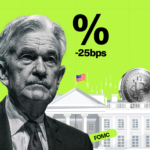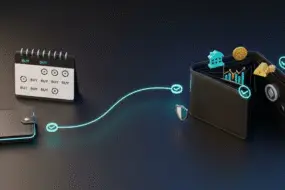
Cryptocurrency trading is exciting, fast-moving, and often unpredictable. Prices can swing by several percent in minutes. Without clear planning, this volatility can wipe out gains or lead to heavy losses. To manage these risks, traders use two essential tools: take profit (TP) and stop loss (SL).
These are not magical buttons that guarantee success, but they are fundamental tools for risk management. By setting automatic exit levels, you reduce emotional decision-making, secure profits, and cap losses before they grow. This guide explains what take profit and stop loss mean, how to set them, and how to apply them effectively on platforms like Bitunix.

What is a Take Profit Order?
A take profit order (TP) is an instruction that automatically closes a trade when your chosen profit target is reached.
- It locks in profits without you needing to watch the charts 24/7.
- Once the price hits the TP level, your position closes instantly.
- This prevents greed-driven mistakes such as “just holding for a little more” and then losing gains.
Example 1 (BTC trade):
You buy Bitcoin at $70,000 and set a TP at $75,000. If BTC climbs to that level, your order executes, securing a $5,000 profit per coin.
Example 2 (ETH trade with futures):
You enter ETH long at $2,500 with 10x leverage and set TP at $2,800. If ETH hits that target, your leveraged position locks in $300 gain per ETH, magnified by leverage.
Example 3 (memecoin with high volatility):
You buy PEPE at $0.0000015 and set a TP at $0.0000020. Since memecoins can swing fast, TP ensures you capture profit even if the price crashes minutes later.
What is a Stop Loss Order?
A stop loss order (SL) is designed to limit losses if the market moves against you.
- For long positions, SL closes the trade if price falls to your chosen level.
- For short positions, SL triggers if the asset rises above your set level.
- It works like insurance—limiting downside while letting upside remain open.
Example 1:
You buy Ethereum at $3,800 and set SL at $3,500. If ETH drops there, your trade closes with only a $300 loss per ETH.
Example 2 (futures short):
You short Solana at $140 with SL at $150. If price rises, your loss is capped at $10 per coin instead of spiraling higher.
Example 3 (volatile token):
You long DOGE at $0.10 with SL at $0.095. If the market dips slightly, your risk is limited to $0.005 per coin.
The Importance of Take Profit and Stop Loss Orders in Crypto Trading
Risk Management
Cryptocurrency markets are notoriously volatile. The primary function of take profit and stop loss orders is to manage this volatility by limiting potential losses and securing profits. These orders help ensure that your losses do not exceed your risk tolerance and that profits are realized before the market can reverse. Setting the stop loss and take profit in cryptocurrency trading is crucial due to the market’s high volatility.
Effective risk management starts with setting a clear risk tolerance level, which defines how much of your capital you are willing to risk on a single trade or over a period, for most traders they prefer using 10% of their funds to invest in cryptocurrency. Utilizing stop loss orders is a fundamental risk management technique, automatically closing positions to prevent excessive losses. Position sizing, determining the number of units to trade based on risk per trade and total capital, helps in managing potential losses effectively.
Emotion Control
Trading cryptocurrencies can be highly emotional due to the rapid price swings. Fear and greed can drive decisions that are not in the trader’s best interest. Stop loss and take profit orders help eliminate the emotional component by automating the decision to close a trade. This disciplined approach can prevent impulsive reactions to market movements because figuring out when to exit the market is vital which is where stop-loss and take-profit levels come into play.
Strategy Implementation
Using take profit and stop loss orders can help in the consistent implementation of a trading strategy. These orders ensure that the strategy is followed even when the trader is not actively watching the markets, which can be particularly useful for those who cannot monitor their trades continuously.
How to Set Take Profit and Stop Loss Orders in Crypto Trading

Determine Your Risk-Reward Ratio
Before setting your orders, it’s crucial to establish a risk-reward ratio. This ratio represents how much you are willing to risk in relation to the potential reward. A common ratio used by traders is 1:2, meaning they are willing to risk $1 to potentially gain $2. This helps in ensuring that the potential profits justify the risks taken.
Stop-loss and take-profit levels are used to calculate a trade’s risk-to-reward ratio. The Risk-to-reward is the measure of risk taken in exchange for potential rewards. Generally, it is better to enter trades that have a lower risk-to-reward ratio as it means that your potential profits outweigh potential risks. Most traders seldom use 10% of their capital to trade.
You can calculate risk-to-reward ratio with this formula:
Risk-to-reward ratio = (Entry price – Stop-loss price) / (Take-profit price – entry price)
Analyze Market Conditions
Market analysis, including technical and fundamental analysis, can provide insights into where to set your take profit and stop loss orders. Key factors to consider include support and resistance levels, market trends, and volatility.
How to Calculate Take Profit and Stop Loss levels
Traders use various ways to utilize and determine the stop-loss and take-profit levels. These approaches may be used independently or in combination with other methods, but the aim is still the same: to use existing data to make more informed decisions about when to close a position. Support and resistance levels are areas on a price chart that are more likely to experience increased trading activity, be it buying or selling.
At support levels, downtrends are expected to pause due to increased levels of buying activity. At resistance levels, uptrend are expected to pause due to increased levels of selling activity. Together with the Fibonacci Retrenchment tool, the support and resistance pivots are great exit and entry point in a trade.
Traders who use this method typically set their take-profit level just above the support level and stop-loss level right below the resistance level they have identified.
Lets look into the fundamentals of Support and Resistance.
Set the Take Profit Order
To set a take profit order, consider:
- Fixed Reward Method: Based on your risk-reward ratio, determine the profit level that corresponds to your desired reward. For example, with a 1:2 ratio, if your stop loss is set to risk $100, your take profit should aim for a $200 profit.
- Resistance Levels: Identify resistance levels (price levels where the cryptocurrency tends to face selling pressure) and set your take profit just below these levels. This ensures you capture profits before the price has a chance to reverse.
- Trailing Take Profit: Use a trailing stop to adjust the take profit level dynamically as the price moves in your favor. This allows you to lock in gains progressively while still giving your trade room to grow.

Practical Examples in Cryptocurrency Trading
Let’s assume you are trading Bitcoin, currently priced at $30,000. After analysis, you decide the following:
– Entry Price: $30,000
– Stop Loss: $28,000 (risking $2,000 per Bitcoin)
– Take Profit: $35,000 (targeting $5,000 profit per Bitcoin)
– Risk-Reward Ratio: 1:2.5
You set a stop loss order at $28,000 and a take profit order at $35,000. If the price drops to $28,000, your stop loss order will sell the Bitcoin, limiting your loss to $2,000 per Bitcoin. If the price rises to $35,000, your take profit order will sell the Bitcoin, securing a $5,000 profit per Bitcoin.
In Ethereum trading, let’s say you buy ETH at $2,500. After evaluating the market, you decide:
– Entry Price: $2,500
– Stop Loss: $2,300 (risking $200 per ETH)
– Take Profit: $2,800 (targeting $300 profit per ETH)
– Risk-Reward Ratio: 1:1.5
You place a stop loss order at $2,300 and a take profit order at $2,800. If the price falls to $2,300, the trade closes automatically, limiting your loss to $200 per ETH. If the price reaches $2,800, the trade closes, securing a $300 profit per ETH.
Common Mistakes Beginners Make
- Stops too tight: Gets stopped out during normal volatility.
- No SL at all: Risk of liquidation in futures trades.
- Greedy TP targets: Setting unrealistic levels that never trigger.
- Failure to adjust: Not updating orders when market conditions change.
- Ignoring fees and slippage: Can reduce actual profit/loss compared to planned TP/SL.
Conclusion
Take profit and stop loss orders are fundamental tools for crypto traders. A take profit order secures gains automatically, while a stop loss prevents losses from spiraling out of control. Together, they form the backbone of disciplined trading.
On Bitunix, you can set TP/SL easily on both spot and futures trades, with features like trailing stops and monitoring thresholds. Always reassess if your position moves more than 2% in the last hour or comes within 1% of stop-loss. By using these tools, traders can survive volatility, preserve capital, and trade with confidence.
FAQs
What does TP mean in trading?
TP means take profit. It is an order that closes your position when your chosen profit target is hit, locking in gains.
What does TP and SL mean in trading?
TP = take profit, SL = stop loss. Together they define automatic exit levels for both profits and losses, reducing the need for emotional decisions.
Should you use TP with every trade?
Yes. Using both TP and SL ensures you plan exits before emotions interfere. Skipping them increases risk, especially in volatile crypto.
How to use TP in trading?
Decide your target before entering the trade. For example, set TP just below resistance while combining it with SL below support. This ensures balanced risk.
What is a good TP SL ratio?
Traders often aim for 1:2 or 1:3 risk–reward. This means risking $1 to make $2–$3.
What is TP in cryptocurrency?
In crypto, TP closes a trade once your profit goal is reached, whether on spot or futures markets.
How do TP buy crypto?
If you are shorting, a TP “buy” order will automatically buy back the crypto at your profit target.
What does TP hit mean in trading?
It means your take profit order executed successfully because the price reached your target.
How to check stop loss and take profit on Bitunix?
Go to the Positions tab on Bitunix. Here you can edit, monitor, or cancel TP/SL orders.
About Bitunix
Bitunix is one of the world’s fastest growing professional derivatives exchanges, trusted by over 3 million users across more than one hundred countries. Ranked among the top exchanges on major data aggregators, Bitunix processes billions in daily volume and offers a comprehensive suite of products including perpetual futures with high leverage, spot markets, and copy trading. Users can trade bitcoin and other major cryptocurrencies on the platform, taking advantage of advanced trading features. Known for its Ultra K line trading experience and responsive support, Bitunix provides a secure, transparent, and rewarding environment for both professional and everyday traders. Bitunix Academy adds structured lessons so you can build skills while you trade.
Bitunix Global Accounts
X | Telegram Announcements | Telegram Global | CoinMarketCap | Instagram | Facebook | LinkedIn | Reddit | Medium
Disclaimer: Trading digital assets involves risk and may result in the loss of capital. Always do your own research. Terms, conditions, and regional restrictions may apply.












